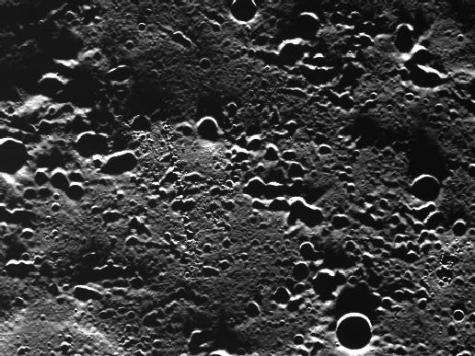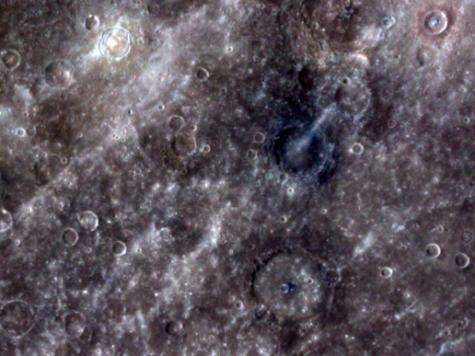This WAC image showing a never-before-imaged area of Mercury’s surface was taken from an altitude of 450 km (280 miles) above the planet during the spacecraft’s first orbit with the camera in operation. The area is covered in secondary craters made by an impact outside of the field of view. Some of the secondary craters are oriented in chain-like formations. This image was taken during MESSENGER’s closest approach to the sunlit portion of the surface during this orbit, just before crossing over the terminator. The oblique illumination by the Sun causes the long shadows and accentuates topography. The highly elliptical orbit of MESSENGER brings the spacecraft down to a periapsis (MESSENGER’s closest approach to Mercury) altitude of 200 km (125 miles) and out to an apoapsis (MESSENGER’s farthest distance from Mercury) altitude of 15,000 km (9300 miles). Image Credit: NASA/Johns Hopkins University Applied Physics Laboratory/Carnegie Institution of Washington
NASA scientists pored Wednesday over stunning new images of Mercury as their MESSENGER probe began a year-long mission to map the surface of the solar system's least-understood planet.
After a 4.9-billion-mile (7.9-billion-kilometer) journey that took six-and-a-half years, the MErcury Surface, Space ENvironment, GEochemistry, and Ranging spacecraft finally entered the planet's orbit on March 17.
MESSENGER could unlock the secrets of a planet where temperatures reach a mind-boggling 800 degrees Fahrenheit (427 degrees Celsius) during the day but plummet to minus 150 degrees (minus 100 degrees Celsius) at night.
Despite its relative proximity to the Earth, Mercury has been little explored because it is the closest planet to the Sun and therefore subject to enormous gravitational pulls and massively high levels of radiation.
The first image, released on Tuesday, showed a dark crater called Debussy, while the lower part revealed a portion of Mercury near its south pole that has never before been photographed by a spacecraft.
MESSENGER, the first spacecraft ever placed in Mercury's orbit, captured 363 more images over six hours, 224 of which had been transmitted back to eager NASA scientists by Wednesday afternoon.
"Mercury has many mysteries, and now we will be able to get the close-up information that will unlock these secrets," said James Head, a geological sciences professor who is part of the MESSENGER team.
"In the coming year, we will be making discoveries every day, answering old questions and revealing new mysteries that we can't even suspect today.
"On Earth, we don't understand how plate tectonics started several billion years ago. Mercury may hold the answer," Head said.
"We also want to know that if the material in the permanently shadowed craters on Mercury is water ice, how does it get there in this hellishly hot environment? Could this be a record of the history of water in the solar system?"
The wide-angle camera (WAC) is not a typical color camera. It can image in 11 colors, ranging from 430 to 1020 nm wavelength (visible through near-infrared). It does this with a filter wheel: the 11 narrow-band filters (plus one clear filter) are mounted onto a wheel that can be rotated to allow the camera to capture an image through each filter. In this image the 1000 nm, 750 nm, and 430 nm filters are displayed in red, green, and blue, respectively. Several craters appear to have excavated compositionally distinct low-reflectance (brown-blue in this color scheme) material, and the bright rays of Hokusai crater to the north cross the image. During MESSENGER’s orbital operations, we will typically use just eight of the WAC's filters. This decision was made to reduce the amount of data that must be stored on the spacecraft’s solid-state recorder before the information can be downlinked. It’s also quicker than cycling through all 11 filters - the spacecraft is moving rapidly over the surface, and there isn't much time to image the same spot on the surface 11 times over before moving to the next area of interest. The sets of color images will help us learn about the variation in composition from place to place on the planet. For example, some minerals such as olivine and pyroxene often absorb more light at longer wavelengths than at shorter ones, so we’ll be looking for their signatures in the reflectance spectra derived from each eight-color set. WAC images will be used in coordination with the Mercury Atmospheric and Surface Composition Spectrometer (MASCS), a hyperspectral instrument that provides reflectance information at many more wavelengths, but only for one spot on the surface at a time. Image Credit: NASA/Johns Hopkins University Applied Physics Laboratory/Carnegie Institution of Washington
Mariner 10, an earlier probe that made three passes of Mercury in 1974 and 1975 mapped out about 45 percent of the surface of the planet. NASA hopes now to be able to complete that work.
MESSENGER will begin continuous mapping on April 4, orbiting the planet every 12 hours at a minimum altitude of 124 miles (200 kilometers).
Scientists believe enormous volcanic eruptions produced many of Mercury's expansive plains, which are littered with meteor craters, and say its strong magnetic field appears to be generated by a molten iron core.
MESSENGER, a 1,067-pound (485-kilogram) robotic probe, was launched in August 2004, making one flyby of Earth, two of Venus and three of Mercury before entering its new orbit.
"The entire MESSENGER team is thrilled that spacecraft and instrument checkout has been proceeding according to plan," said mission spokesman Sean Solomon of the Carnegie Institution for Science in Washington.
"The first images from orbit and the first measurements from MESSENGER's other payload instruments are only the opening trickle of the flood of new information that we can expect over the coming year. The orbital exploration of the solar system's innermost planet has begun."
Named after the Roman messenger god, hence the name of the NASA probe, Mercury is heavily cratered and similar in appearance to the Moon. It is the smallest of the eight planets and orbits the Sun every 87.969 Earth days.
(c) 2011 AFP
























